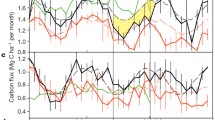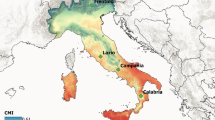Abstract
Making predictions as to how heatwaves will affect forests in the future is a major challenge in ecosystem science, not the least because we have few documented examples of how they respond now. We captured the effects of drought and a record-breaking heatwave on whole-tree water use (Q) in Eucalyptus regnans during the summer drought of 2008/2009 in southeastern Australia. While air temperatures steadily increased, average maximum sap flow (J Smax) declined with progression of the drought prior to the heatwave. In the period approaching the heatwave, Q during daytime (Q d) steadily declined, while nighttime Q (Q n) increased. This pattern was particularly pronounced during nights that followed hot days (>32 °C) where Q n was frequently 20–30 % of Q d. We found clear trends in the relation of Q d to Q n that point to the increasing importance of refilling depleted stem water stores following hot days. On the day the heatwave climaxed (7 February 2009), sap flow (J S) was dramatically low, and declined as weather conditions became increasingly arid (air temperature > 42 °C, vapor pressure deficit >7 kPa). Almost immediately after the heatwave passed J S resumed its common diurnal hysteresis, albeit at slightly slower rates. In the context of prognosticated effects of future climate, our data highlight that depletion and refill of stored water in E. regnans are likely important features for the tree to endure drought- and heat-related climatic extremes. We suggest that elucidating the peculiarity of capacitance and defining its threshold for keystone tree species, such as E. regnans, can add to our understanding of how climatic extremes may affect forests.






Similar content being viewed by others
References
Attiwill PM, Adams MA (1996) Nutrition of Eucalyptus. CSIRO, Melbourne
Allen CD, Macalady AK, Chenchouni H, Bachelet D, McDowell N et al (2010) A global overview of drought and heat-induced tree mortality reveals emerging climate change risks for forests. For Ecol Manage 259:660–684
Ashton DA (1975) The root and shoot development of Eucalyptus regnans F. Muell. Aust J Bot 23:867–887
Ashton DA, Attiwill PM (1994) Tall open-forests. In: Groves HD (ed) Australian vegetation. Cambridge University Press, Melbourne, pp 157–196
Benyon RG (1999) Nighttime water use in an irrigated Eucalyptus grandis plantation. Tree Physiol 19:853–859
Bleby TM, Burgess SSO, Adams MA (2004) A validation, comparison and error analysis of two heat-pulse methods for measuring sap flow in Eucalyptus marginata saplings. Funct Plant Biol 31:645–658
Borchert R, Pockman WT (2005) Water storage capacitance and xylem tension in isolated branches of temperate and tropical trees. Tree Physiol 25:457–466
Borken W, Matzner E (2009) Introduction: impact of extreme meteorological events on soils and plants. Glob Change Biol 15:781
Bovard BD, Curtis PS, Vogel CS, Su B-H, Schmid HP (2005) Environmental controls on sap flow in a northern hardwood forest. Tree Physiol 25:31–38
Brodribb TJ, Holbrook NM (2006) Declining hydraulic efficiency as transpiring leaves dessicate: two types of response. Plant Cell Environ 29:2205–2215
Buckley T, Turnbull TL, Pfautsch S, Adams MA (2011) Nocturnal water loss in mature subalpine Eucalyptus delegatensis tall open forest and adjacent E. pauciflora woodlands. Ecol Evol 1:435–450
Burgess SSO, Adams MA, Turner NC, Beverly CR, Ong CK et al (2001) An improved heat pulse method to measure low and reverse rates of sap flow in woody plants. Tree Physiol 21:589–598
Burgess SSO, Dawson TD (2007) Predicting the limits to tree height using statistical regressions of leaf traits. New Phytol 174:626–636
Ciais P, Reichstein M, Viovy N, Granier A, Ogée N et al (2005) Europe-wide reduction in primary productivity caused by the heat and drought in 2003. Nature 437:529–533
Connor DJ, Legge NJ, Turner NC (1977) Water relations in Mountain Ash (Eucalyptus regnans F. Muell.) forests. Aust J Plant Physiol 4:753–762
Dawson TE, Burgess SSO, Tu KP, Oliveira RS, Santiuago LS et al (2007) Nighttime transpiration in woody plants from contrasting ecosystems. Tree Physiol 27:561–575
DeBoeck HJ, Dressen FE, Janssens IA, Nijs I (2010) Climatic characteristics of heat waves and their simulation in plant experiments. Glob Change Biol 16:1992–2000
England JR, Attiwill PM (2007) Changes in sapwood permeability and anatomy with tree age and height in the broad-leaved evergreen species Eucalyptus regnans. Tree Physiol 27:1113–1124
England JR, Attiwill PM (2006) Changes in leaf morphology and anatomy with tree age and height in the broadleaved evergreen species Eucalyptus regnans F. Muell. Trees 20:79–90
Fischer EM, Seneviratne SI, Lüthi D, Schär C (2007a) Contribution of land–atmosphere coupling to recent European summer heat waves. Geophys Res Lett 34: – . doi:10.1029/2006GL029068
Fischer EM, Seneviratne SI, Vidale PL, Lüthi D, Schär C (2007b) Soil moisture–atmosphere interactions during the 2003 European summer heat wave. J Clim 20:5081–5099
Fisher JB, Baldocchi DD, Mission L, Dawson TD, Goldstein AH (2007) What the towers don’t see at night: nocturnal sap flow in trees and shrubs at two AmeriFlux sites in California. Tree Physiol 27:597–610
Flint AW, Fagg PC (2007) Mountain Ash in Victoria’s State Forests. Silvicultural reference manual no. 1. Department of Sustainability and Environment, Melbourne
Goldstein G, Andrade JL, Meinzer FC, Holbrook NM, Cavelier J, et al. (1998) Stem water storage and diurnal patterns of water use in tropical forest canopy trees. Plant Cell Environ 21:397–406
Gutschick VP, BassiriRad H (2003) Extreme events as shaping physiology, ecology, and evolution of plants: toward a unified definition and evaluation of their consequences. New Phytol 160:21–42
Granier A, Reichstein M, Bréda N, Janssens IA, Falge E et al (2007) Evidence for soil water control on carbon and water dynamics in European forests during the extremely dry year: 2003. Agric For Meteorol 143:123–145
Holbrook NM (1995) Stem water storage. In: Gartner BL (ed) Plant stems: physiology and functional morphology. Academic, San Diego, pp 151–174
IPCC (2011) Special report on managing the risks of extreme events and disasters to advance climate change adaptation (SREX)—summary for policymakers. International Panel on Climate Change, Geneva
Jeffrey SJ, Carter JO, Moodie KM, Beswick AR (2001) Using spatial interpolation to construct a comprehensive archive of Australian climate data. Environ Modell Softw 16:309–330
Jentsch A, Kreyling J, Elmer M, Gellesch E, Glaser B et al (2011) Climate extremes initiate ecosystem-regulating functions while maintaining productivity. J Ecol 99:689–702
Jentsch A, Kreyling C, Beirkuhnlein C (2007) A new generation of climate-change experiments: events not trends. Front Ecol Environ 5:365–374
Ladjal M, Epron D, Ducrey M (2000) Effects of drought preconditioning on thermotolerance of photosystem II and susceptibility of photosynthesis to to heat stress in cedar seedlings. Tree Physiol 20:1235–1241
Lorenz DJ, DeWeaver ET (2007) The response of the extratropical hydrological cycle to global warming. J Clim 20:3470–3484
Macfarlane C, Bond C, White DA, Grigg AH, Ogden GN, et al. (2010) Transpiration and hydraulic traits of old and regrowth eucalypt forest in southwestern Australia. For Ecol Manage 260:96–105
McDowell N, Pockman PT, Allan CD, Breshears DD, Cobb N et al (2008) Mechanisms of plant survival during drought: why some plants survive while others succumb to drought? New Phytol 178:719–739
Meinzer FC, James SA, Goldstein G, Woodruff D (2003) Whole-tree water transport scales with sapwood capacitance in tropical forest canopy trees. Plant Cell Environ 26:1147–1155
Petit G, Pfautsch S, Anfodillo T, Adams MA (2010) The challenge of tree height in Eucalyptus regnans: when xylem tapering overcomes hydraulic resistance. New Phytol 187:1146–1153
Pfautsch S, Keitel C, Turnbull TL, Braimbridge MJ, Wright TE et al (2011) Diurnal patterns in water use of Eucalyptus victrix indicate pronounced desiccation-rehydration cycles despite unlimited water supply. Tree Physiol 31:1041–1051
Pfautsch S, Bleby TM, Rennenberg H, Adams MA (2010) Sap flow measurements reveal influence of temperature and stand structure on water use of Eucalyptus regnans forests. For Ecol Manage 259:1190–1199
Phillips NG, Lewis JD, Logan BA, Tissue DT (2010) Inter- and intra-specific variation in nocturnal water transport in Eucalyptus. Tree Physiol 30:586–596
Phillips NG, Ryan MG, Bond BJ, McDowell NG, Hinckley NM et al (2003) Reliance on stored water increases with tree size in three species in the Pacific Northwest. Tree Physiol 23:237–245
Phillips OL, Aragão LEOC, Lewis SL, Fisher JB, Lloyd J et al (2009) Drought sensitivity of the Amazon rainforest. Science 323:1344–1347
Pieruschka R, Huber G, Berry JA (2010) Control of transpiration by radiation. Proc Natl Acad Sci USA 107:13372–13377
Porporato A, D’Odorico P, Laio F, Ridolfi L, Rodriguez-Iturbe I (2002) Ecohydrology of water-controlled ecosystems. Adv Water Resour 25:1335–1348
Rennenberg H, Loreto F, Polle A, Brilli F, Beniwal RS et al (2006) Physiological responses of forest trees to heat and drought. Plant Biol 8:556–571
Scholz FG, Phillips NG, Bucci SJ, Meinzer FG, Goldstein G (2011) Hydraulic capacitance: biophysics and functional significance of internal water sources in relation to tree size. In: Meinzer FC, Lachenbruch B, Dawson TE (eds) Size- and age-related changes in tree structure and function. Springer, New York, pp 341–362
Smith MD (2011) The ecological role of climate extremes: current understanding and future prospects. J Ecol 99:651–655
Snyder RL, Shaw RH (1984) Converting humidity expressions with computers and calculators. Leaflet 21372, Cooperative Extension, Division of Agriculture and Natural Resources, University of California
Sperry JS, Meinzer F, McCulloh KA (2008) Safety and efficiency conflicts in hydraulic architecture: scaling from tissues to trees. Plant Cell Environ 31:632–645
Trenberth KE, Shea DJ (2005) Relationships between precipitation and surface temperature. Geophys Res Lett 32. doi:10.1029/2005GL022760
Teuling AJ, Senevirante SI, Stöckli R, Reichstein M, Moors E et al (2010) Contrasting responses of European forest and grassland energy exchange to heatwaves. Nat Geosci 3:722–727
Tyree M, Sperry J (1988) Do woody plants operate near the point of catastrophic xylem dysfunction caused by dynamic water stress? Answers from a model. Plant Physiol 88:574–580
Valladares F, Pearcy RW (1997) Interactions between water stress, sun-shade acclimation, heat tolerance and photoinhibition in the sclerophyll Heteromeles arbutifolia. Plant Cell Environ 20:25–36
Vautard R, Yiou P, D’Andrea F, de Noblet N, Viovy N et al (2007) Summertime European heat and drought waves induced by wintertime Mediterranean rainfall deficit. Geophys Res Lett 34. doi:10.1029/2006GL028001
Vertessy RA, Hatton TJ, Reece P, O’Sullivan SK, Benyon RG (1997) Estimating stand water use of large mountain ash trees and validation of the sap flow measurement technique. Tree Physiol 17:747–756
Whitehead D, Beadle CL (2004) Physiological regulation of productivity and water use in Eucalyptus: a review. For Ecol Manage 193:113–140
Wullschleger SD, Hanson PJ, Todd DE (1996) Measuring stem water content in four deciduous hardwoods with a time-domain reflectometer. Tree Physiol 16:809–815
Zweifel R, Häsler R (2001) Dynamics of water storage in mature subalpine Picea abies: temporal and spatial patterns of change in stem radius. Tree Physiol 21:561–569
Acknowledgments
The authors would like to thank Michael Kemp and Chris Weston for practical help in the field and Tina Bell, Mark Tjoelker, Craig Macfarlane and several anonymous reviewers for valuable discussions on the draft manuscript.
Author information
Authors and Affiliations
Corresponding author
Additional information
Communicated by Todd Dawson.
Rights and permissions
About this article
Cite this article
Pfautsch, S., Adams, M.A. Water flux of Eucalyptus regnans: defying summer drought and a record heatwave in 2009. Oecologia 172, 317–326 (2013). https://doi.org/10.1007/s00442-012-2494-6
Received:
Accepted:
Published:
Issue Date:
DOI: https://doi.org/10.1007/s00442-012-2494-6




